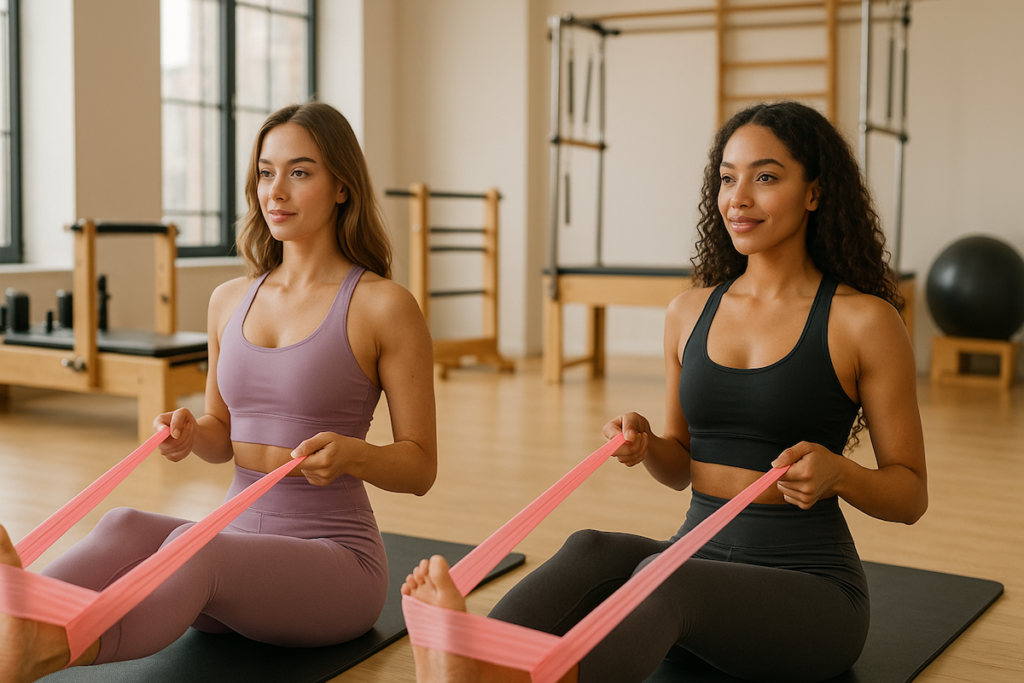
Why Grip Socks Are Essential for Your Pilates Practice?
The science behind grip socks is straightforward but impactful. The strategic silicone or PVC patterns on the soles create friction against smooth surfaces, preventing slips during dynamic movements and holds. This simple innovation addresses multiple aspects of Pilates practice simultaneously.
Joseph Pilates emphasized precision and control in movement as cornerstones of his method. Without proper stability, these qualities become difficult to achieve. Modern grip socks provide the secure foundation necessary to focus on form rather than worrying about sliding feet—something especially important when working on slippery surfaces like studio reformers or home hardwood floors.
Benefits of Wearing Grip Socks During Your Practice
- Enhanced stability for more precise movements
- Improved hygiene by creating a barrier between feet and shared equipment
- Better proprioception (awareness of body position) through tactile feedback
- Increased confidence during challenging balance exercises
- Protection for feet against friction and cold surfaces
- Proper alignment support through stable positioning
- Reduced risk of slips and injuries during dynamic movements
How to Choose the Right Pilates Grip Socks?
Finding your perfect pair requires considering several key features that impact both performance and comfort:
Types of Grip Socks
Full-Toe Socks: Traditional sock design with individual toe coverage and grips across the entire sole. These provide comprehensive coverage and warmth while maintaining necessary traction.
Five-Toe (Toe Separator) Socks: Feature individual compartments for each toe, enhancing foot articulation and balance while preventing toe overlapping. These are excellent for exercises requiring precise foot movements.
Half-Toe (Toeless) Socks: Cover the ball of the foot while leaving toes exposed for direct contact with the floor. These offer a balance between barefoot feel and grip enhancement.
Ballet-Style Socks: Feature an elastic strap across the top of the foot, mimicking ballet slippers. These stay securely in place during extensive movements while providing elegant aesthetics.
Grip Patterns and Coverage
The pattern and extent of grip coverage significantly impact performance:
- Full-sole coverage: Provides maximum stability for all positions
- Targeted grip points: Strategic placement at pressure points for natural movement
- Honeycomb or circular patterns: Offer balanced grip without restricting foot movement
- Linear patterns: Provide directional stability for certain movements
Material Considerations
Quality materials make a substantial difference in both performance and longevity:
- Cotton blends: Breathable and comfortable but may lose shape over time
- Bamboo fibers: Naturally antimicrobial with excellent moisture-wicking properties
- Performance synthetics: Offer superior moisture management and durability
- Organic cotton options: Eco-friendly with reduced chemical exposure
The 8 Best Pilates Grip Socks for Women in 2025
After extensive testing and consultation with Pilates instructors, we’ve selected the eight best grip socks that combine performance, comfort, and style. Our recommendations accommodate different preferences, foot types, and practice intensities.

How to Get the Most from Your Pilates Grip Socks?
To maximize the benefits of your grip socks during practice:
Proper Fit and Sizing
- Most brands size by shoe size, but check specific brand guidelines
- Socks should feel snug but not restrictive
- No excess material should bunch at toes or heel
- Consider foot width—some brands offer regular and wide options
- If between sizes, size down for better performance
Care and Maintenance
Proper care significantly extends the life of your grip socks:
- Turn inside out before washing to protect grip patterns
- Hand wash with mild soap for maximum longevity
- If machine washing, use gentle cycle in mesh laundry bag
- Air dry only—heat damages elastic and grip materials
- Avoid fabric softeners which can reduce grip effectiveness
- Replace when grips begin to wear smooth (typically 6-12 months with regular use)
When to Wear Grip Socks?
While highly beneficial, grip socks aren’t necessary for every situation:
Best for:
- Reformer, chair, and barrel work
- Slippery floor surfaces (hardwood, tile)
- Studio environments (hygiene)
- Balance-intensive exercises
- Rehabilitation work
Consider alternatives for:
- Exercises requiring foot articulation against resistance
- Specific foot therapy movements
- Textured mat work where additional grip may be excessive
Addressing Common Grip Sock Concerns
Many practitioners have questions about incorporating grip socks into their practice:
“Won’t grip socks prevent me from feeling the floor?”
While barefoot practice does offer maximum sensory feedback, quality grip socks provide enough tactile information while adding stability benefits. Five-toe and open designs especially maintain significant sensory connection with minimal compromise.
“Are grip socks just for beginners?”
Quite the contrary—many advanced practitioners and instructors rely on grip socks for their technical advantages. The stability they provide often enables more advanced movements and transitions with greater control.
“How many pairs do I really need?”
For regular practitioners (2-3 sessions weekly), we recommend at least three pairs to allow rotation and proper cleaning between uses. Daily practitioners often maintain 5-7 pairs for convenience and hygiene.
Conclusion: Finding Your Perfect Foundation
The right pair of grip socks becomes an extension of your practice—enhancing stability, hygiene, and confidence without drawing attention to themselves. By understanding the different styles, materials, and grip patterns available, you can select the perfect pair for your unique feet and practice style.
Remember that like other aspects of Pilates, personal preference plays an important role. What works perfectly for one practitioner may feel restrictive to another. Don’t hesitate to try different styles until you find your ideal match—your practice will thank you for the attention to this often-overlooked foundation.
Ready to explore more ways to enhance your home Pilates studio? Check out our complete guide to essential Pilates equipment and our review of the best Pilates resistance bands for your practice.


